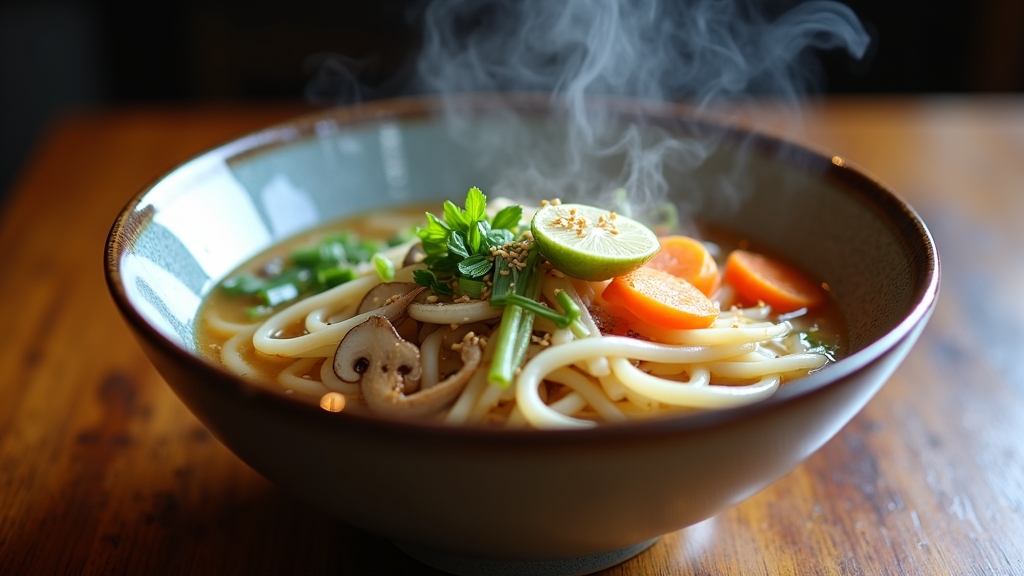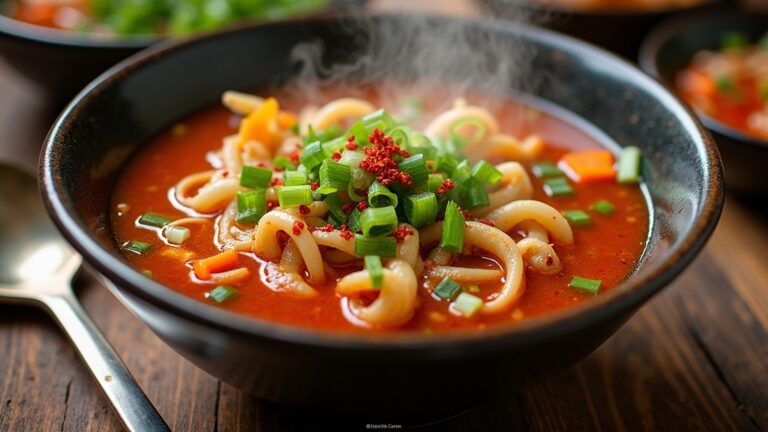Udon Noodle Recipe Soup
I love making udon noodle soup, a deliciously comforting dish with thick, chewy noodles and a rich broth. To start, I prepare a savory dashi or vegetable broth, then add soy sauce, mirin, and fresh veggies like shiitake mushrooms and spinach. The noodles cook to tender perfection, and I love sprinkling green onions and sesame seeds for extra flavor. It’s versatile and perfect for any season, and you’ll find even more ways to personalize it if you keep going!
Contents
History
When I think about udon noodle soup, I can’t help but appreciate its rich history that stretches back centuries. The udon origins trace back to Japan during the Heian period, where these thick, chewy noodles were a staple in the diet of the nobility. Over time, they evolved, becoming a beloved comfort food for all classes. Udon’s cultural significance is profound; it’s often enjoyed during celebrations and gatherings, symbolizing unity and nurturing. Each bowl tells a story, connecting generations through shared meals. As I explore innovative twists on this classic dish, I’m reminded that while culinary trends may change, the deep-rooted traditions behind udon remain a comforting constant, inviting us to experience its timeless essence.
Recipe
Udon noodle soup is a warm and comforting dish that hails from Japan, known for its thick, chewy noodles and flavorful broth. This versatile dish can be customized with a variety of toppings and ingredients, making it perfect for any season. Whether you enjoy it with vegetables, proteins, or a combination of both, this udon noodle soup recipe will guide you through creating a delicious bowl of goodness that brings a taste of Japan right to your kitchen.
Making udon noodle soup is not only simple but also a great way to explore different flavors and textures. The key to a perfect udon soup lies in the broth, which can be made from scratch or enhanced with store-bought stock. With just a few fresh ingredients and a bit of time, you can prepare a hearty meal that will satisfy your cravings and warm your soul.
Making udon noodle soup is a delightful way to explore flavors, with a focus on a rich, satisfying broth.
Ingredients:
- 200g dried udon noodles
- 4 cups dashi broth (or vegetable broth)
- 2 tablespoons soy sauce
- 1 tablespoon mirin
- 1 teaspoon sesame oil
- 1 cup sliced shiitake mushrooms
- 1 cup spinach
- 1 carrot, julienned
- 2 green onions, chopped
- 2 soft-boiled eggs (optional)
- Seaweed sheets (nori), for garnish
- Sesame seeds, for garnish
To prepare the udon noodle soup, start by cooking the udon noodles according to the package instructions. While the noodles are cooking, bring the dashi broth to a simmer in a separate pot. Stir in the soy sauce, mirin, and sesame oil, then add the shiitake mushrooms and carrots. Allow the vegetables to cook for about 5 minutes or until tender. Once the udon noodles are cooked, drain them and add them to the broth along with the spinach. Stir everything together and let it simmer for an additional 2-3 minutes to combine the flavors. Serve the soup hot, garnished with soft-boiled eggs, chopped green onions, nori, and sesame seeds.
When making udon noodle soup, consider experimenting with different toppings and ingredients based on your preferences. You can add proteins such as tofu, chicken, or shrimp for a heartier meal. Additionally, feel free to incorporate seasonal vegetables like bok choy, snow peas, or bell peppers. If you prefer a spicier kick, a dash of chili oil or fresh chili slices can elevate the flavor profile. Enjoy your homemade udon noodle soup!
Cooking Steps
Now that we’ve gathered our ingredients, let’s jump into the cooking steps that will bring this udon noodle soup to life. I’ll guide you through preparing the rich broth, adding the soy sauce mixture, and incorporating the noodles for that perfect texture. With a sprinkle of green onions at the end, you’ll have a bowl of comfort that’s truly satisfying.
Step 1. Prepare Broth Ingredients
To create a rich and flavorful broth, I gather a handful of key ingredients that infuse the soup with depth. Balancing broth flavors is essential, so I pay close attention to ingredient proportions. Here’s what I typically select:
- Dashi: A Japanese stock that brings umami and complexity.
- Miso paste: Adds a creamy texture and savory notes.
- Seaweed: Such as kombu, which enhances the broth’s depth.
- Shiitake mushrooms: They contribute earthiness and richness.
- Garlic and ginger: These aromatics elevate the overall flavor profile.
Each ingredient plays an important role in crafting a broth that’s not only delicious but also memorable. By thoughtfully combining these elements, I guarantee my udon noodle soup is a true culinary delight.
Step 2. Add Soy Sauce Mixture
As the broth simmers to perfection, I prepare the soy sauce mixture that will elevate its flavor. I whisk together a rich blend of soy sauce, mirin, and a touch of sesame oil, each ingredient contributing to the overall harmony. The umami from the soy sauce adds a depth that’s simply irresistible. I let the mixture sit for a moment, allowing the flavors to meld and intensify. Once the broth is bubbling, I gradually stir in the soy sauce mixture, watching as it transforms the liquid into a vibrant, savory elixir. The aroma fills the kitchen, promising a delicious bowl of udon soup. This flavor enhancement is what takes a good broth to extraordinary, inviting everyone to savor each delightful spoonful.
Step 3. Add Noodles to Broth
With the soy sauce mixture seamlessly integrated into the simmering broth, it’s time to add the udon noodles. I gently drop the noodles into the bubbling mixture, watching as they begin to soften and absorb the rich flavors of the broth. The beauty of this dish lies in the harmony of diverse noodle varieties and broth types working together.
- Udon’s chewy texture provides a delightful contrast.
- Ramen or soba can be innovative alternatives.
- A miso broth adds a creamy depth.
- Experimenting with spicy or herby broths can elevate the dish.
- Don’t forget to stir gently to prevent sticking!
This step is where the magic happens, transforming simple ingredients into a comforting bowl of goodness.
Step 4. Garnish With Green Onions
A sprinkle of fresh green onions can elevate your udon noodle soup to new heights. When I’m looking to enhance the flavor and presentation, I rely on simple garnish techniques that make a big impact. Chopping the green onions finely allows their vibrant color and mild, slightly sweet flavor to shine. Not only do they add a burst of freshness, but the green onion benefits also include essential vitamins and antioxidants that promote health.
For a creative twist, I sometimes sauté a handful of green onions in sesame oil before garnishing, infusing the soup with a delightful aroma. Experimenting with different amounts and styles of green onion garnish lets me customize each bowl, making every serving a unique experience.
Step 5. Simmer Until Noodles Are Tender
After garnishing your udon noodle soup with those vibrant green onions, it’s time to focus on cooking the noodles to perfection. I bring the broth to a gentle simmer, carefully adding the udon noodles. As they cook, I keep a close eye on their progress, engaging in some tenderness testing.
- Visual cues: Look for the noodles to soften and slightly expand.
- Taste test: Sample a noodle to check for that delightful chewiness.
- Timing: Follow the package instructions, adjusting for your desired texture.
- Stir gently: This prevents the noodles from sticking together.
- Flavor absorption: Let the noodles soak in the broth’s flavors, enhancing every bite.
With these steps, your udon will be ready to enjoy!
Nutritional Guide
While enjoying a steaming bowl of udon noodle soup, you might wonder about its nutritional benefits. This comforting dish isn’t just delicious; it can be a great addition to your healthy eating habits. Packed with essential nutrients, a typical serving of udon noodles provides energy and satisfaction without overwhelming your calorie count.
Here’s a quick glance at the nutritional values:
| Nutrient | Amount per Serving |
|---|---|
| Calories | 200 |
| Protein | 7g |
| Carbohydrates | 40g |
| Fat | 1g |
| Fiber | 2g |
With its balance of nutrients, udon noodle soup can be both a hearty meal and a nourishing option. Enjoy every bite while knowing you’re fueling your body!
Final Thoughts
Although I could savor a bowl of udon noodle soup any day, it’s the dish’s comforting blend of flavors and textures that truly captivates me. Each spoonful is a reminder of how versatile this soup can be. I love experimenting with different soup variations and ingredient substitutions to make it uniquely mine.
The comforting blend of flavors in udon noodle soup inspires me to experiment and create my own unique variations.
- Swap traditional dashi for a miso base for a richer flavor.
- Add seasonal vegetables like bok choy or mushrooms for a fresh twist.
- Try protein alternatives such as tofu or seitan for a plant-based option.
- Enhance the broth with spices like ginger or chili for a kick.
- Top with fresh herbs like cilantro or scallions for brightness.
Make it your own, and enjoy every delicious moment!
Frequently Asked Questions
Can I Use Other Noodles Instead of Udon?
I’ve swapped udon for rice noodles, soba noodles, egg noodles, and even zucchini noodles. Each brings a unique texture and flavor, making the dish exciting and innovative. Don’t hesitate to experiment!
What Can I Substitute for Dashi Broth?
Finding a substitute for dashi broth feels like discovering a hidden gem. I’ve used alternative broths like vegetable or chicken, adding flavor enhancements like soy sauce or seaweed for depth and richness. It’s deliciously innovative!
How Long Can I Store Leftover Udon Soup?
I usually store leftover soup in an airtight container for up to three days. When I reheating it, I enjoy adding fresh herbs for a burst of flavor, making every bowl feel revitalized and new.
Is Udon Noodle Soup Gluten-Free?
Udon’s unique, unyielding texture isn’t gluten-free, but I’ve discovered delightful udon alternatives like rice or buckwheat noodles. They offer gluten-free options that still deliver satisfying slurps and scrumptious flavors. Give them a try!
Can I Add Meat or Seafood to the Soup?
I love adding various meat options like chicken or beef, and I can’t resist seafood varieties such as shrimp or scallops. They elevate the flavor and create a heartier, more satisfying bowl. Enjoy experimenting!
Conclusion
To sum up, making udon noodle soup is like a warm hug on a chilly day—it comforts the soul and delights the senses. With its rich history and simple ingredients, you can create a dish that not only nourishes but also brings a taste of tradition to your table. I encourage you to gather your ingredients, embrace the process, and savor every spoonful. Trust me, once you try it, you’ll want to share this experience with everyone you know!











